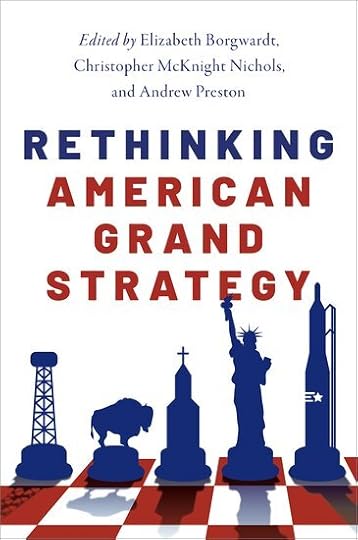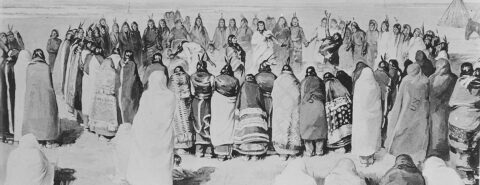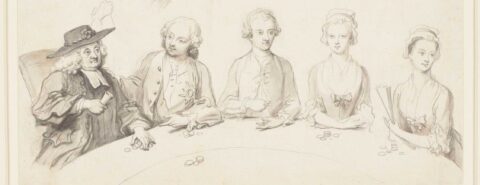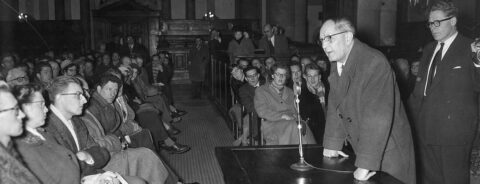Oxford University Press's Blog, page 37
December 12, 2023
Genomic insights into the past and future of the black rhinoceros

Genomic insights into the past and future of the black rhinoceros
The iconic African black rhinoceros (Diceros bicornis) faces an uncertain future after intense poaching caused a 98% decline in wild populations from 1960 to 1995. While numbers are currently increasing, the animal remains critically endangered.
The historical range of the black rhinoceros covered vast swaths of sub-Saharan Africa, but today’s remaining individuals inhabit just a handful of protected areas. The survival of the black rhinoceros within the fragmented remains of its natural habitat relies on dedicated conservation efforts. A study published in Molecular Biology and Evolution, “Historic Sampling of a Vanishing Beast: Population Structure and Diversity in the Black Rhinoceros”, reshapes our understanding of the evolutionary and natural history of the black rhinoceros, opening a window into the species’ genetic past while urging us to forge a path toward its conservation.
 By comparing historical and modern genomes sánchez Barrerio & De Cahsan et al. uncovered the extent of human-mediated loss of population diversity in black rhinoceros. Illustration by Barrerio & De Cahsan et al.
By comparing historical and modern genomes sánchez Barrerio & De Cahsan et al. uncovered the extent of human-mediated loss of population diversity in black rhinoceros. Illustration by Barrerio & De Cahsan et al.The study characterizes the population structure and genomic diversity of the black rhinoceros, both before and after its range-wide collapse in the last century, providing a model for how genetic diversity is shaped during population contractions. “The only way to really explore this is to use species with well documented, temporal collections that are also tied to good demographic records,” says Thomas Gilbert, one of the study’s lead authors. “Sadly, species like the black rhinoceros are a perfect example, given their long-term appeal to big game hunters and poachers.” The motivation for the study, however, extended beyond mere scientific curiosity according to co-first author Binia De Cahsan Westbury: “Studying the genetic history of the black rhinoceros through time provides crucial insights into its evolutionary trajectory and aids in developing effective conservation strategies for its remaining populations.”
With this goal, the authors sequenced the genomes of 63 museum specimens collected from 1775 to 1981, as well as 20 individuals from modern black rhinoceros populations, compiling the most comprehensive genetic dataset of the species to date and significantly advancing earlier research efforts. “Whole genome sequences have revealed much more conservation-relevant population structure in the black rhinoceros than expected from traditional markers,” notes the study’s other lead author, Yoshan Moodley, emphasizing the transformative power of cutting-edge genomic techniques.
Analysis of the data revealed the presence of six major black rhinoceros populations historically as well as four subpopulations, offering more precise delineation of population borders than ever before. Notably, the results suggested that tectonic rifts in Africa during the Pleistocene had “driven the evolution of several hitherto unknown populations, many of which probably still exist within the present day Kenyan metapopulation,” highlights Moodley.
In addition to geographical barriers, the evolutionary history of the black rhinoceros was shaped by secondary contact when these barriers to gene flow were temporarily removed. “The interplay of these events has resulted in a significant pattern of isolation by distance across the sub-Saharan territory of the species,” says De Cahsan Westbury, referring to a trend in which populations that are farther apart geographically also show greater genetic differences from each other.
The researchers further evaluated levels of inbreeding among historical and modern populations of the black rhinoceros, an essential consideration for species that have suffered severe population bottlenecks. “Modern samples underscore the profound impact of population contractions and subsequent genetic drift,” notes De Cahsan Westbury, “with southern African individuals experiencing the most severe effects and the highest inbreeding among all populations.” Some populations showed evidence of inbreeding that predated the colonial period, which highlights the long-standing impact of human activity on this species according to the study’s authors.
Altogether, the study offers a resounding call to action to improve the conservation and management of the black rhinoceros. “For too long, wildlife conservation authorities have struggled to incorporate and implement urgent genetic recommendations, to the detriment of the biodiversity concerned,” notes Moodley. “It is absolutely crucial that the new populations identified in East Africa be given the highest conservation priority,” he emphasizes, echoing the study’s urgent plea for comprehensive genetic testing of black rhinoceroses in Kenya and Tanzania. In addition, the distinct evolutionary groups identified in the study, such as the Ruvuma, Maasai Mara-Serengeti, and possibly Chyulu National Park subpopulations, should be the focus of separate management to maintain their unique genetic lineages.
The study pays homage to the late Professor Mike Bruford of Cardiff University, a prominent figure in conservation genetics and a co-author of the project. His death “was a tragedy for not only his family but conservation biology in general,” note the authors. Bruford’s legacy continues to influence the field, an enduring testament to the pursuit of knowledge and the protection of Earth’s genetic heritage.
Featured image by Ron Porter via Pixabay.
December 11, 2023
Chick Webb meets Chick Webb: Fact and fiction in James McBride’s new novel

Chick Webb meets Chick Webb: Fact and fiction in James McBride’s new novel
Chick Webb’s drumbeats resonate through much of James McBride’s fast-paced new novel The Heaven & Earth Grocery Store. McBride, one of America’s most beloved authors today, weaves Webb into this story early on. One of the main characters, Moshe Lublow, a Jewish immigrant theater owner in Pottstown, a Pennsylvania backwater, hires Chick Webb’s band for his All-American Dancehall and Theater. This is no transient visit. Instead, McBride, a noted musician himself, conjures up Webb’s “masterful drumming, a thunderous band shaking the floor with rip-roaring waves of gorgeous sound,” and paints Webb as a “joymaker” in this wild tale of cross-cultural mayhem and a rescue mission.
I was riveted. Not just by McBride’s description of Webb’s mesmerizing performance to a packed house, but as Webb’s biographer. Rhythm Man, the first full-length biography of the innovative Swing-era drummer/bandleader who died age 34 in June 1939, at the height of his band’s fame, came out in April 2023. Just a few months later, here comes Chick Webb, a key fictional presence in McBride’s thrilling book. These two books came out—somewhat literally—on each other’s dancing heels, though Webb hasn’t been a headliner in jazz, or pop music and dance cultural circles, for years.
This publishing coincidence posed a big question: where does fiction meet reality and why? Why is the fictional Chick even here? The main reason becomes clear soon enough. The Heaven & Earth Grocery is run by Moshe’s wife Chona, disabled since childhood from polio, with a deformed foot and lifelong limp, and Chona and the store are neighborhood lifelines. Meanwhile the real-life Chick Webb, only four feet tall with a deformed spine, was partially disabled from childhood due to spinal tuberculosis. He was a different kind of lifeline. His band was a training ground for emerging musicians at their home base at Harlem’s world-famous Savoy Ballroom, and he, like Chona, took chances on all kinds of people. They were both dynamic and compelling, and were also people with disabilities, a major theme in the novel. McBride is a master at creating characters, as well as using now-unmentionable words: “Cripples, Moshe thought, have brought me fortune: Moses, Chona, and Chick.”
In McBride’s first few chapters Webb’s role is vital for other reasons, too. He is the first Black bandleader whom Moshe hires for his dancehall/theater, an unprecedented move that engages the town’s Black residents. McBride’s descriptions of Webb’s orchestra in action with dancers are spot on, and the fictional Webb is true to life: his small stature, curved spine, white suit, and transportive drumming. While this makes Moshe’s business thrive it also stirs up trouble with the town’s white patriarchy.
Some of McBride’s jazz timeframe and details make the story a little farmisht, (Yiddish for confused or mixed up). Webb first comes to Moshe’s dancehall/theater in Pottstown in 1924, followed by other top Black big bands soon after. Historically, that’s 12 years before the big swing bands took over America’s airwaves and dance floors. Webb’s bandleading career didn’t begin until 1926 and he didn’t have a “roaring 12-piece big band” until the early 1930s, and added more horns when he could afford them. As McBride’s novel develops, 1936 is the key year in Heaven & Earth’s major storyline, when Swing really is a pop cultural force. Suddenly I was suspended between fact and fiction.
“Where does fiction meet reality and why?”
Meanwhile, there really is a Pottstown, PA, an hour’s drive northwest of Philadelphia. It’s also true that Chick Webb and his band crossed the color line numerous times in a variety of segregated and/or mixed-race venues, en route to fame, when Webb’s band with a young Ella Fitzgerald became one of the biggest acts in the country. Curiously, Ella doesn’t enter the story, though Webb helped set Ella and several other key musicians—like Louis Jordan and Mario Bauza, who do appear in this book—on their paths as musical giants and “influencers.” For McBride, the fame belongs to Chick.
Yiddishisms are sprinkled throughout Heaven & Earth, in which Jews, Blacks, and the microcosmic melting pot of Pottstown’s Chicken Hill neighborhood struggle for pieces of the American pie. McBride knows these people, places, and pastimes. He portrays Moshe as one of the most benign and conflicted Jewish entertainment “gatekeepers” that Webb ever had to negotiate with in real-time.
Webb’s presence ebbs as the novel’s main plot picks up. The story now focuses on Chicken Hill’s neighbors as they join forces to save Dodo, a deaf Black boy— another resilient and smart “cripple”—from a notorious state-run institution. I was heartbroken when Chick disappeared. McBride’s earthy magic realism had Webb popping off the pages into my head. Fortunately, he is too important a character to vanish entirely.
Webb reappears mid-way through the book. Moshe calls Chick for help when Louis Armstrong cancels a date as headliner. Moshe had heard rumors that Webb was sick. So is Chona, who is lying in a coma in the nearest hospital. Chick is happy to help Moshe out and suggests another band since his can’t fill in. Now. Moshe is heartbroken when he realizes that Webb, “his old pal… the wonderful hunchbacked musical genius, was very ill. ‘Get Mario Bauza and his Afro-Cubans,’ Webb croaked over the phone. ‘They’re fantastic.’”
Once again, McBride derails jazz history with fictionalized backstage scenes that are still true-to-life. Bauza accepts Moshe’s last-minute gig, but just before show-time has a screaming argument with Gladys Hampton, Lionel Hampton’s wife and manager, over whose band was supposed to be the main act. In “reality,” Hampton didn’t start his own band until 1940, encouraged by Gladys, a tough business woman but no tempest. Bauza, one of Webb’s key sidemen from 1933-38, didn’t become the leader of the Afro-Cubans, featuring famous Cuban vocalist Machito, until the early 1940s, after Webb passed away. By then, Afro-Cuban jazz was becoming a musical force.
Reading on, I no longer care who plays with whom, or what year it is. McBride captures the personalities, conflicts, rivalries, and stakes of the music world, and crams these Webb-related musicians under the same fictional roof. This was liberating for me, after studiously “mapping” Webb’s itinerary by poring over hundreds and hundreds of newspaper ads and entertainment columns for years. The Heaven & Earth Grocery Store hurtles to its finale and Dodo escapes to safety. Though some real-time jazz-historical details go off the rails, it’s a powerful novel, true to Webb’s powerful life and spirit.
Featured image by John Matychuk on Unsplash (public domain)
December 6, 2023
More gleanings: cob, shark, cowan, and the rest

More gleanings: cob, shark, cowan, and the rest
After a long dearth of queries, I may report a tiny drizzle and will now answer some of the questions I received in November.
Cob An iconic American cob. StockVault, CC0.
An iconic American cob. StockVault, CC0.Our correspondent writes that his father used to say: “Save me cobs,” requesting the last portion of something to be saved. Do I have anything to report about this request? I of course don’t know where and from whom the old man picked up his phrase, but I know a good deal about the word cob, because I once wrote a long article about it in An Analytic Dictionary of English Etymology: An Introduction. Such monosyllabic words can mean almost anything. The senses merge, and it is often hard to tell whether we are dealing with one word or several homonyms. Below, I’ll follow the explanation in the relevant entry as it appears in The Century Dictionary (a great multivolume reference work). The various nouns spelled cob are chiefly of regional origin and are or were current in predominantly British dialects (in the US, we first and foremost remember corncob). That is why it might be useful to know where our correspondent’s father was born and lived in his youth. The earliest sense of cob seems to have been “head.” Other than that, we find that cob often looks like a variant of cop “head” (again “head”!) and cub “(roundish) lump” (cub “a young animal” is not far behind). Among other recorded senses, “cobnut,” “a head of wheat,” “a kind of wicker basket,” and so forth turn up. It appears that in the phrase save me cobs, the word cob goes back to the sense “lump.” For amusement’s sake, see the last item in this post!
SharkA few days ago, I read a long article by an Italian researcher about the history of the Scandinavian word for “shark” and remembered that I once had a post about the mysterious fish name (May 23, 2012: “Bigger in size but equally ignorant”). Since that time, I have not discovered any new works on this subject and find some of my old conclusions acceptable, but I have rather seriously changed my views on word creation. The reason is that I have acquainted myself with numerous studies on the history of slang and written more than once on the role of sound symbolism in etymology. The lines above on cob are a case in point. Let me repeat the main part of that section: practically any round object can be called cob or cub, or cop, or cup, and the impulse behind this name giving remains a mystery. With sound-imitation everything is clear: crack, creak, croak; bow-wow, oink-oink, and their likes are self-explanatory. But what is there in gl– that we hear in glow, gleam, glint, glory, glamor, and so forth or in fl– in flow, fly, flitter, flutter, flatter, flimsy, and the rest? Why should cop, cup, cub, and cob be associated with roundness?
Slang is our main lab for observing new coinages. Every time I see a word like flub or wonk I stop reading and look up their etymology. The answer is almost invariably: “Origin unknown.” Do they have an origin? What is there we don’t know? Now back to shark. I’ll cite the explanation from The Century Dictionary and then part of an entry from Earnest Weekley’s An Etymological Dictionary of Modern English (1921). The Century Dictionary: “Not found in Middle English (the Middle English name therefor [sic] being hound-fish): usually derived from Latin carcharus, from Greek karkharías, a kind of shark, so called from its sharp teeth… But the requisite Old French forms intermediate between English shark and Latin carcharus are not found, and it is not certain that the name was first applied to the fish; it may have been first used of a greedy man.”
Walter W. Skeat, our greatest authority on English etymology, cited this conclusion with approval. The fish name was first recorded in 1569, and shark “scoundrel” surfaced in a text thirty years later, which means that it was current at least some time before. Weekley wrote a short article about shark in 1910 (of course, for Notes and Queries!), and this is the statement in his dictionary: “Although recorded as fish-name somewhat earlier than in sense of greedy parasite, I think the latter is the original sense, and that the word came perhaps via Dutch, from German Schurke “a shark, sharper, rook, rake, rogue….” Today, most etymologists seem to share Weekley’s opinion. I stick to my doubts of ten years ago. If shark was a slang word, perhaps a term from the international sixteenth-century cant, it would hardly have been used as a special fish name. It can be imagined that someone would have said in jest about an unfamiliar sea creature: “We encountered a huge voracious troll,” but it is harder to picture a path from troll to a new fish name that would have supplanted the old, perfectly transparent one (houndfish and dogfish). Until we find out why the 1569 sailors used a seemingly new word, the origin of shark will remain “unknown.”
I also wonder: did those English sailors know the German word Schreck(en) or Dutch schrikk “fright”? The group shr-k might perhaps have a sound-symbolic value and carry negative connotations (fear, abuse, and the like). If so, then shark “scoundrel,” an entirely different homonym, may belong here, without being the source of the fish name. The sound-imitative value of shr– is obvious in shrill, shriek, and perhaps in shrub and shrug. Be that as it may, too bad they did not call the fish flub or wonk.
 What a Schreck / schrikk! Photo by Mile Ribeiro.Cowan
What a Schreck / schrikk! Photo by Mile Ribeiro.CowanThe word was the subject of the post for October 4, 2023. Though the origin of the word remains obscure, it is not improbable that cowan reached English from French. Our correspondent informs us that in Cajun French, in southwest Louisiana, cowan is a vulgar term for “vagina” (something like “pussy”). This may be and probably is a mere coincidence. Yet it is not entirely improbable that English cowan had at one time reference to sex and was a vulgar word. As I mentioned in discussing another obscure word (brocard: see the post for October 25, 2023), when a language historian has nothing to say about the origin of a word, every clue matters. Even if it fails to provide the answer, it may suggest a promising path to the solution.
 A short arm is good, a long arm is better. Photo by Alena Darmel.Local idioms
A short arm is good, a long arm is better. Photo by Alena Darmel.Local idiomsI was asked whether I had encountered idioms restricted to one family or to a very narrow circle. Some idioms are indeed known to few, but their rarity may be an illusion. Thus, many correspondents to Notes and Queries wrote between 1911 and 1924 that they used the phrase to make a long arm, which meant “to help oneself to something far from the place where one is sitting.” The phrase was known on both sides of the Atlantic, though in the United States, only on the East Coast, and all the letter writers believed that it was their family quip. The moral is: never assume that the peculiar phrase you use is not known elsewhere. Amazingly, the earliest recorded example in the OED goes back to 1593!
December 5, 2023
10 things direct reports must do to get the most out of their 1:1 meetings

10 things direct reports must do to get the most out of their 1:1 meetings
1:1s are crucial in promoting positive outcomes such as increased employee engagement, higher retention rates, more innovation, and overall success for the team member, manager, and organization. A lot of focus is placed on the manager’s role in orchestrating 1:1s, where they are responsible for addressing direct reports’ practical and personal needs. However, it is also important to recognize that direct reports have agency in 1:1s and should play an active, not passive, role in the effectiveness of these meetings. When direct reports feel empowered to seek help, there are benefits to both the individual and organization.
As an employee, you need to take an active role in your 1:1s to get the most out of them. These 10 key behaviors are critical in making sure you are receiving the help that you need to grow in your career:
Know what you need: be ready to discuss your own needs, hopes, and goals, not just what you think you should say to your manager.Be curious: do not just have a curious mindset, but also engage in curious behaviors such as asking questions, listening, and challenging yourself to discover new things.Build rapport: get to know your manager on a personal and professional level by learning about their interests.Actively engage: get the most out of your meeting by doing things like asking questions, expressing yourself, taking notes, and paying attention to non-verbal communication like maintaining good eye contact.Communicate well: strive to be clear, concise, focused, honest and pay attention to voice infliction and tone. For difficult conversations, consider practicing before bringing them to your manager.Problem solve: come to your 1:1 not only with your problems but also possible solutions. Be ready to constructively discuss counterarguments and differing viewpoints.Ask for help (constructively): seek assistance from your manager that encourages independent problem solving. This includes asking to recommendations or help of others when your manager cannot assist you.Ask for feedback: ask specific questions that focus on receiving suggestion on future behaviors such as “I want to improve at X, do you have any suggestions on how to get better at this?”Receive feedback well: show that you are appreciative of the feedback by thanking your manager and asking further questions about issues that were raised.Express gratitude: let your manager know you are grateful for their time and feedback.Finally, as you proceed with these behaviors, it is important to keep in mind the science around asking for help. Namely, help-seeking behaviors have been categorized by social psychologists into two main types: autonomous help-seeking and dependent help-seeking.
Autonomous help-seeking can be understood as seeking information that enables individuals to be independent, accomplish tasks, and solve problems on their own. This tends to promote long-term independence—similar to the adage, “Give a person a fish and they’ll eat for a day but teach them to fish and they’ll eat for a lifetime.”
Dependent help-seeking, on the other hand, refers to searching for a “quick fix” and an “answer” from someone else. This style of help-seeking conserves time and effort and leads to immediate gratification, but typically doesn’t yield long-term self-sufficiency. Interestingly, job performance ratings have been shown to have a positive relationship with autonomous help-seeking, but a negative relationship with its counterpart—dependent help-seeking.
Bottom line: do your part in the 1:1 to maximize its value to you and approach it as an opportunity to learn to be the best you can seeking meaningful insights that enable you to thrive and grow both short-term and long-term.
Featured image via Unsplash (public domain)
December 4, 2023
“Happy Birthday” to the Linguistic Society of America

“Happy Birthday” to the Linguistic Society of America
This January, the Linguistic Society of America will celebrate its 100th anniversary. The effort to create a Linguistic Society, one dedicated to “the advancement of the scientific study of language,” took root in 1924. The first meeting was held in December of that year and its flagship journal Language began publication in March of 1925.
Among other things, much of the Linguistic Society’s history is presented in Frederick J. Newmeyer’s excellent American Linguistics in Transition: From Post-Bloomfieldian Structuralism to Generative Grammar, which documents issues, events, and personalities from the 1920s through the 1980s. Today, the Linguistic Society draws up to 1,300 attendees at its early January meetings, which alternate between convention-ready cities in the eastern, central, and western US.
The LSA, as it is known, shares a lot of interests with the American Dialect Society (founded in in 1889) and the North American Association for the History of the Language Sciences (founded in 1987), which meet at the same time and place. Over the years (and before the pandemic), the Society also met together with American Name Society (founded in 1951), the Society for Pidgin and Creole Linguistics (founded in 1989), and the Society for the Study of the Indigenous Languages of the Americas (founded in 1981).
With over 3,000 members, the Linguistic Society also sponsors minicourses, student fellowships, awards, and a number of special interest sections. And since 1928 it has facilitated biennial Summer Institutes where scholars and students gather for a month-long program of courses, special lectures, and social events.
Like all organizations, the Linguistic Society has had its ups and downs, but many linguists are planning to gather in the city where it all began—New York and to celebrate the last century and think about the next hundred years of the scientific study of language. And one thing you can be sure will happen is that “Happy Birthday” will be sung.
Not just because it is the Society’s birthday, but because the song has a special connection to the Linguistic Society. “Happy Birthday” was written in 1893 by two sisters, Mildred Jane Hill and Patty Smith Hill, teachers in Louisville, Kentucky. After considerable legal wrangling with a publisher who claimed to hold the copyright, the Hill family set up a trust and a charitable foundation which had a share of the royalties.
You can read about the copyright history in Robert Brauneis’s 2009 article “Copyright and the World’s Most Popular Song” in the Journal of the Copyright Society of the U.S.A. Mildred Hill, a musicologist, died in 1916; Patty passed away in 1946, and a third sister, Jessica Mateer Hill (who together with Patty managed the foundation and family trust) died in 1951. At that point, the trust revenue went to the nephew of the sisters, a University of Texas linguistics professor named Archibald A. Hill. Hill joined the Linguistic Society in 1928, served as Secretary-Treasurer from 1950-1968 and as the Society’s president in 1969.
And when Archibald Hill died in 1992, the assets of the trust became the property of the Association for Childhood Education, as per the instructions in Jessica Hill’s will. The remainder of his estate went to a family friend. While he did not leave the rights to “Happy Birthday” to the LSA, as some have wondered, Hill was a savvy steward of the LSA funds as Secretary-Treasurer. Today the Society’s Washington, DC, headquarters are in the Archibald A. Hill Suite at the Monroe House.
As for “Happy Birthday,” a legal settlement in 2016 placed the song in the public domain, so I’m pretty sure linguists will be singing it in January.
Featured image by Luca Bravo via Unsplash
December 1, 2023
Remembering the legacy of Henry Kissinger [reading list]

Remembering the legacy of Henry Kissinger [reading list]
As a key architect of US foreign policy during the Nixon and Ford administrations, Henry Kissinger left an indelible mark on international relations. His realpolitik approach, emphasizing power dynamics and pragmatic statecraft, shaped the geopolitical landscape during the Cold War and beyond. Below is a small roundup of studies of his life, policies, and legacy.
 1.
Fire and Rain: Nixon, Kissinger, and the Wars in Southeast Asia
1.
Fire and Rain: Nixon, Kissinger, and the Wars in Southeast Asia
By Carolyn Woods Eisenberg
This gripping account interweaves Nixon and Kissinger’s pursuit of the war in Southeast Asia with on-the-ground military events and US domestic reactions to the war conducted in Vietnam, Laos, and Cambodia. Drawing upon a vast collection of declassified documents, Fire and Rain presents an important reinterpretation of the Nixon administration’s relations with the Soviet Union and China in light of the war.
2. The Flawed Architect: Henry Kissinger and American Foreign Policy
By Jussi M. Hanhimäki
Henry Kissinger dominated American foreign relations like no other figure in recent history. He negotiated an end to American involvement in the Vietnam War, opened relations with Communist China, and orchestrated détente with the Soviet Union. Yet he is also the man behind the secret bombing of Cambodia and policies leading to the overthrow of Chile’s President Salvador Allende. In The Flawed Architect historian Jussi Hanhimaki paints a subtle, carefully composed portrait of America’s most famous and infamous statesman.
3. Nixon, Kissinger, and the Shah: The United States and Iran in the Cold War
By Roham Alvandi
Nixon, Kissinger, and the Shah offers a detailed account of the Nixon-Kissinger-Pahlavi partnership that shaped the global Cold War far beyond Iran’s borders. Drawing on American, British, and Iranian sources, this study restores agency to the shah as an autonomous international actor and suggests that Iran evolved from a client to a partner of the United States under the Nixon Doctrine. Alvandi deftly explores how the US’s relationship with Shah changed after Nixon and Kissinger’s historic 1972 visit to the country, mapping the rise and fall of Iran’s Cold War partnership with the United States.
 4.
Nixon in the World: American Foreign Relations, 1969-1977
4.
Nixon in the World: American Foreign Relations, 1969-1977
Edited by Fredrik Logevall and Andrew Preston
In the 1970s, the United States faced challenges on a number of fronts. By nearly every measure, American power was no longer unrivalled. The task of managing America’s relative decline fell to President Richard Nixon, Henry Kissinger, and Gerald Ford. Edited by Pulitzer Prize winner Fredrik Logevall and Andrew Preston, this volume provides authoritative and compelling analyses from seventeen leading historians on issues such as Vietnam, détente, arms control, and the US-China rapprochement, creating a comprehensive volume on American foreign policy in this pivotal era.
5. A Superpower Transformed: The Remaking of American Foreign Relations in the 1970s
By Daniel J. Sargent
In A Superpower Transformed, Daniel J. Sargent chronicles how policymakers across three administrations worked to manage complex international changes in the 1970s. Drawing on many newly released archival documents and interviews with key figures, including President Jimmy Carter and Dr. Zbigniew Brzezinski, Sargent explores the collision of geopolitics and globalization that defined the decade. Focusing on Kissinger, Nixon, Ford, Carter, and Brzezinski, A Superpower Transformed shows how decision-makers responded to the dilemmas of this tumultuous era.
6. Rethinking American Grand Strategy
Edited by Elizabeth Borgwardt, Christopher McKnight Nichols, and Andrew Preston
Kissinger made significant contributions to American grand strategy during his time as both National Security Advisor and Secretary of State. His approach was characterized by a combination of realism, balance of power, and a focus on diplomacy. Rethinking American Grand Strategy assembles a roster of leading historians to examine America’s place in the world and how strategists such as Kissinger worked to get it there.
Featured image by Robert Linder on Unsplash (public domain).
November 28, 2023
A spotlight on Native American language and religion [podcast]

A spotlight on Native American language and religion [podcast]
The October release of Martin Scorsese’s latest film Killers of the Flower Moon has thrust the sordid history of America’s treatment of its indigenous peoples back into the public eye.
On today’s episode of The Oxford Comment, the last for 2023, inspired by the themes in Killers of the Flower Moon, and in celebration of National Native American Heritage Month in the United States, we spotlight two aspects of Native American culture that transcend tribe and nation and have been the recent focus of OUP scholars: language and religious beliefs.
For our first interview, we were joined by Rosemarie Ostler, author of The United States of English: The American Language from Colonial Times to the Twenty-First Century, to speak about the Native American English dialect, how English became more widely spoken amongst Native Americans, and current programs to preserve Native American languages. We then spoke with Gregory Shushan, author of Near-Death Experience in Indigenous Religions about near-death experiences, Native American myths, shamanism, and religious revitalization movements across indigenous cultures in North America.
Check out Episode 89 of The Oxford Comment and subscribe to The Oxford Comment podcast through your favourite podcast app to listen to the latest insights from our expert authors.
Oxford Academic (OUP) · A Spotlight on Native American Language and Religion – Episode 89 – The Oxford CommentRecommended readingYou can read the chapter “Ethnic Dialects” from Rosemarie Ostler’s book, The United States of English: The American Language from Colonial Times to the Twenty-First Century, which presents the evolution of American English not as a dry collection of linguistic facts, but as an ever-changing story that’s part of the country’s larger cultural and political history.
Read the chapter exploring near-death experiences (NDEs) in “North America” from Gregory Shushan’s book, Near-Death Experience in Indigenous Religions, which examines the role culture plays in how people experience and interpret NDEs, and reveals how afterlife beliefs often originate in such extraordinary experiences.
You may also be interested in the chapter “Possession and dispossession: religion in Native America”, from Timothy Beal’s Religion in America: A Very Short Introduction.
If you want to learn more about Indigenous languages, keep an eye out for Lyle Campbell’s upcoming title, The Indigenous Languages of the Americas: History and Classification, and Nicholas Limerick’s Recognizing Indigenous Languages: Double Binds of State Policy and Teaching Kichwa in Ecuador.
Transcript The-Oxford-Comment-Episode-89-transcriptFeatured image: Arapaho Ghost Dance, 1900, U.S. National Archives and Records Administration via Wikimedia Commons (public domain)
November 24, 2023
Falling dice and falling ministers: explaining an artwork in the Royal Collection

Falling dice and falling ministers: explaining an artwork in the Royal Collection
 Royal Collection Trust / © His Majesty King Charles III 2023
Royal Collection Trust / © His Majesty King Charles III 2023This curious drawing in the Royal Collection, attributed to William Hogarth but possibly by Phillipe Mercier, depicts a game of hazard, the ancestor of modern casino “craps.” An attribution to Mercier is supported by the figure of a young man wearing an order of chivalry (possibly the Garter, although the ribbon is worn over the wrong shoulder) who bears a strong resemblance to Mercier’s portraits of Frederick, Prince of Wales. Mercier was appointed painter to the Prince and Princess of Wales soon after the accession of George II allowed Frederick to set up his own household.
The staffage of the drawing is unusual, given the subject matter. Women as well as men sit at the hazard table, despite the strictures of Richard Steele that throwing dice was not ladylike. Even more remarkable is the clergyman who holds the dice box. Given the august company, he might be a bishop, and in fact, closely resembles Hogarth’s portrait of Benjamin Hoadly, bishop of Salisbury and later of Winchester. There are not many circumstances that would explain how, in the words of Frances Burney, these individuals became so strangely situated.
One such is Twelfth Night, 5 January, as it was observed at court, when the sovereign, Royal Family, and courtiers played hazard for the benefit of the Groom Porter, the court official charged with procuring and dispensing small furnishings. Since these could include cards and dice, the Groom Porter was inextricably associated with games of chance at court, as the final authority, for example, on the rules of games. The drawing may be an unfinished sketch for a painting, never undertaken, to commemorate the revels of a particular Twelfth Night, that of January 1731, whence our story.
The years after the Hanoverian Succession saw a concerted effort to suppress gambling operations, such as tables for hazard and faro, conducted in taverns, coffeehouses, and other public accommodations in London and Westminster. Apart from any moral hazard they posed (and there were admonitions aplenty in print culture), the “silver tables” at Vanderman’s coffeehouse in Covent Garden or at the Phoenix tavern in the Haymarket were competition for the Government’s own gaming operations, the lotteries it used to fund public works, freeing up other revenue to bankroll an expanding military and naval establishment.
Spurred by Charles, second Viscount Townshend, holder of the office that evolved into the Home Secretary, the magistrates of Westminster (where most of these gambling parlors were housed) authorized raids on premises determined to be “common” (i.e. public) “gaming houses” open to all comers in violation of statute. The magistrates were thwarted, however, at every turn by resourceful, well-connected, and above all well-lawyered gambling entrepreneurs, as adept at gaming the system as they were at reaping the benefits that mathematical probability afforded them.
It did not help that gambling went forward with impunity at court, as the royal household was explicitly exempted from all legislation aimed at proscribing or regulating games of chance. Townshend deployed all of the powers of his office to support the prosecution of gaming operations, authorizing the Crown’s attorneys to defend constables at public expense when gaming entrepreneurs sued them, and funding rewards for those who informed on gaming operators. A widely circulated pamphlet recounting the efforts of the Westminster magistrates and the obstacles they faced apparently originated in Townshend’s office.
George I and (briefly) George II were evidently pressed to set an example, and for the decade of the 1720s, hazard was banished from the Twelfth Night revels in favor of ombre, a polite card game played for relatively low stakes. By the end of that decade, however, Townshend had fallen out with the Prime Minster, Sir Robert Walpole, who happened to be his brother-in-law, and by the spring of 1730, Townshend had resigned, returning to Raynham in Norfolk to promote the cultivation of turnips. Raids on gaming venues slowed dramatically, ceasing entirely by 1735. And no sooner was Townshend out of office than hazard immediately resumed on Twelfth Night at court, with the King, Queen, Prince of Wales, and the three princesses winning nearly a thousand guineas among themselves. Hazard continued as the game of preference as Twelfth Night was observed at court for at least the next decade, even after subsequent legislation outlawed it, along with basset and faro, as an illegal lottery.
The sketch in the Royal Collection certainly looks like a study for the sort of conversation piece for which Hogarth was particularly known, and which Mercier was known to have undertaken as well. Assuming that Twelfth Night of 1731 was the intended subject, there may have been any number of reasons that the project was abandoned. Newspaper reports of the revival of hazard at court festivities that week in January appeared in the same issues as accounts of raids on gaming venues; not long afterward, Captain William Bradbury, the recently ousted deputy to the Groom Porter Thomas Archer, wrote letters to newspapers threatening to expose his former employer. It was not the time to draw attention to this sort of courtly practice. What might seem to courtiers to be a harmless seasonal amusement might look to the public like insupportable hypocrisy.
Did you enjoy this blog post? You may have access to the entire book on Oxford Academic. Sign in via your institution and start reading The Gambling Century today.
Flow of time: reality or illusion?

Flow of time: reality or illusion?
Real time of space-time is one of the dimensions on which we comprehend and describe reality. Time neither flows, nor flies, or drags on; it doesn’t run out and is not a commodity that can be wasted. But human feelings and sensations of the passage of time are diametrically different: human time flows, speeds up or slows down. We can also be short of it, or we can be called time-wasters. So, human time does not appear to be in the least like physicist’s time. And yet they are intimately related: the first emerged from the latter, together with humans, their consciousness, societies they built, and languages they speak.
But what exactly is this flow of time? And what do different languages tell us about the nature of human time? What theories can we plausibly put forward in philosophy, psychology, anthropology, or linguistics (to name a few) to explain this phenomenon? Does it even exist in the first place, or, perhaps, as many philosophers argue, the feeling of time passing is merely an illusion? Perhaps it is not a sensation of time flow but instead a sensation of something else, like the experienced change of events that we describe to ourselves erroneously as the flow of something we just call “time,” to give this big unknown a helpful label. Time becomes that thing that we (think we) experience, and an entrenched concept in our beliefs (say, that time passes quickly or slowly), knowledge (that death is inevitable), or fears (that I am going to be late).
Speaking about timeIn order to understand human time, we have to ask not only how we think and speak about time but also what it is that makes us think and speak about it in a certain way. We have to look into the experience of time passing, the relation between time and emotions, or the role of time in understanding the evolving (and ageing) self. An important source of information is expressions we use for locating events in time. This can be done through grammar (grammatical tense, such as past, present or future), aspect (such as an activity being in progress or being completed), and modality (such as certainty or the mere possibility of an event); the repository of “time words” a language has (yesterday; in September; within six hours); and through the implied, suggested meanings where the sentence does not contain any of the above overt devices because the specification of the location in time would feel redundant, as in:
What languages reveal and hide
A: Shall we watch Netflix?
B: I’m doing my homework.
Languages do fascinating things with time. In some, like English, a sentence clearly indicates whether an event has already happened, is happening, or will happen. Other languages do no such thing: they have no grammatical tenses. And these are not just flukes of human invention—examples are ample: Yucatec Maya, Mandarin Chinese, Paraguayan Guaraní, Burmese (Sino-Tibetan), Dyirbal (Australian Aboriginal, Pama-Nyungan), West Greenlandic (Kalaallisut, Eskimo-Aleut), Hopi (Uto-Aztecan), or Hausa (Chadic, Afroasiatic), to name a few. Yet others, like Thai, use their tenses sparingly. This opens up the possibility to draw attention to different aspects of the same reality through different ways of speaking about it—perhaps focusing not on when, but on how exactly, to what extent; or whether what the speaker is saying is reliable or just hearsay. Or perhaps whether the event is desired or not.
The latter can be exemplified in Yucatec Maya. For example:
Tàak in xok-ik le periyòodiko-o’
DES 1Sg read-INC(3Sg) DEF newspaper
“I want/wanted/will want to read the paper.”
Adapted from Bohnemeyer, Jürgen, 2002. The Grammar of Time Reference in Yukatek Maya. München: Lincom Europa, p. 6
“DES” is a marker of desiderative aspect-mood. It shows that the grammar of Yucatec Maya foregrounds the fact that reading the newspaper is the speaker’s wish. This information takes precedence over information as to whether the object of the wish was, is, or will be the case, which remains unspecified. “INC” stands for a grammatical marker of the incomplete status of the activity of reading a newspaper, “1/3Sg” for the grammatical person and number (compare English “I” and “it”), and “DEF” for a marker of definiteness (compare English “the”).
Moreover, the human understanding of time can follow the “time stays we go” way or the “time flows” way, as in examples (1) and (2) respectively, both using the metaphorical schema of time as space.
We are approaching the New Year.The New Year is approaching.This can be done by viewing the future as lying ahead of us, as in English, or as being behind us, unknown, and as such still hidden from view, as in Māori. And yet, most linguists and philosophers agree that what lurks under the surface of this immense cross-linguistic variation is something universally human—something imposed on our conceptualization of reality by the very fact that we are human and share the human way of perceiving and processing reality; we are born and then endure through life, stringing along everything that happens as part of one story: a life story.
Once we have reached this level of understanding of human time—time as weaving life stories by humans, on the level of reality on which human consciousness emerged—we can go so much further. We can begin to understand that, ultimately, the universe may not have any “past” or “future” written into them; or it may not even have an “arrow of time,” but instead be symmetrical, directionless. And then we can go back and ask again: If the universe does not have flowing time, or even is directionless, then how is the experience of flowing time possible? Perhaps it itself is an illusion? And how can we get to the bottom of this feeling of time passing? At that point, possible answers are beginning to emerge.
Getting togetherThe sensation that we call the passage of time and the concept of time itself are still big unknowns. But chipping at human time from the direction of the nature of the universe on the one hand and human nature on the other has recently produced important dents in this unknown. For example, we are beginning to understand how free will can be reconciled with the tenet that it emerged from the universe where the past and the future might be equally determined in that the universe itself might be symmetrical. We are also beginning to understand how the immense diversity with which we express temporal thoughts in different languages and cultures is only a patina on something universal. We are also getting better at scientific accounts of the incorrect judgements of time intervals and their causes—that is, time “speeding up” or “slowing down,” say, under the influence of emotions. But all this takes dedicated, concerted, inter- and cross-disciplinary efforts to tackle this big unknown, to understand human time—serious conceptual and experimental work but generating lots of excitement and fun in the process!
Featured image via Unsplash (public domain)
November 23, 2023
The man behind the legend: Martin Niemöller, Hitler’s Personal Prisoner

The man behind the legend: Martin Niemöller, Hitler’s Personal Prisoner
Martin Niemöller, Lutheran pastor in the Dahlem parish at the outskirts of Berlin, stood at the centre of the struggle over hegemony in the German Protestant Church during the Third Reich. As figurehead of the Confessing Church, established in May 1934, Niemöller fought with great energy against the German Christians, a Nazi affiliated group, and their attempt to seize control of the Protestant Churches.
By 1937, Niemöller’s fight against any accommodation with the German Christians was lost. His public rhetoric radicalized. The regime responded by putting Niemöller on trial. Yet on 2 March 1938, the judges effectively acquitted him, taking pre-trial detention into account. On the same day, he was brought to Sachsenhausen concentration camp.
Upon arrival, the camp commander explained to him that he was detained as “Hitler’s Personal Prisoner.” He was kept in solitary confinement, but not subjected to the brutal terror that all other inmates faced.
During the time of his concentration camp detention—he was moved to Dachau in 1941, and liberated in April 1945 by US troops—Niemöller rose to international fame. Especially the media in the UK and the US elevated him to a symbol of Christian resistance against the Nazi dictatorship.
After 1945, Niemöller credited his time in concentration camp detention as the key reason for a fundamental change of heart. In Sachsenhausen and Dachau, he had learned—so he claimed—to discuss openly with Communists, his main political enemies prior to 1933, and to abandon his nationalist worldview.
Yet these claims were wrong. They were part of the Niemöller legend, the rose-tinted image of a chastened former nationalist that was carefully curated and protected by Wilhelm Niemöller, Martin’s younger brother, in many post-war publications. In reality, Martin Niemöller’s nationalist and anti-Bolshevik worldview was undiminished right until the moment of liberation in 1945.
“A rose-tinted image of a chastened former nationalist was carefully curated and protected by Martin’s younger brother.”
His volunteering for the Wehrmacht is an important proof for this point. After the start of the German invasion of Poland on 1 September 1939, Niemöller wanted to support his nation in its fight against a treacherous enemy. In a discussion with his wife Else—she had the right to visit him once a fortnight—on 7 September 1939, he pondered his options.
From 1910 to 1919, Niemöller had served as an officer in the Imperial Navy, having his own command of a U-boat in 1918. Hence, he wrote to High Command of the Navy on 7 September 1939: “As I have waited in vain to be drafted for military service … I hereby apply explicitly as a volunteer for military service.”
Niemöller’s friends and supporters claimed after 1945 that he had intended to escape from detention and join resistance circles within the Wehrmacht. But on the back of his letter from 7 September 1939, he addressed the Gestapo to dispel any doubts:
“I declare on my own account that I will, as a matter of course, make myself available to continue my protective custody immediately after my release from military service.”
The purpose of his volunteering was to support the Wehrmacht in its war against Poland. Yet his demand to join the Navy for combat service was turned down by the High Command of the Armed Forces. When he received the rejection letter, signed by Wilhelm Keitel, Niemöller “was dumbfounded” and his wife Else “had tears streaming from her eyes,” as he recorded in his notes on her next visit.
The campaign against Poland was soon over. However, after the lost battle of Stalingrad in 1943, it became obvious that the German army was facing defeat. Hence, Niemöller, now detained in Dachau concentration camp, considered to volunteer again. On 13 June 1943, he wrote to his wife:
“During the last weeks and months I have often thought about the question whether I should try again and apply for voluntary service; but Keitel’s letter in response to my first attempt does not leave me with the possibility to take the initiative again, although it makes me sick to watch. As long as everything seemed to go well, it was not even half as difficult.”
The defensive war situation in 1943 also refreshed and hardened Niemöller’s anti-Bolshevism. In late April 1943, he wrote to Else: “Sometimes I am tormented by the thought that the whole bloody fighting might end for us in Bolshevism.”
As the Red Army moved closer to Berlin in early 1945, Niemöller’s mood turned gloomy. In February 1945, his son Jochen had written to him, asking “Was Spengler right after all?” Was “The Decline of the West” imminent, as the philosopher Oswald Spengler had suggested in his book with this title, published in 1922. His father’s answer was unequivocal:
“I don’t see how this question could be answered in the negative; because I cannot imagine that the Anglo-Americans care in the slightest about the fate of the European culture; besides, what is left of it anyway? Ruins and a pile of shards.”
Niemöller perceived the moment of liberation in May 1945 in the first instance as a defeat of the German nation. Occupied by Bolsheviks and Anglo-Americans, it faced an uncertain future. Niemöller did indeed abandon his nationalist worldview and anti-Bolshevik stance. Yet he only did so in the decade after 1945.
Oxford University Press's Blog
- Oxford University Press's profile
- 238 followers



